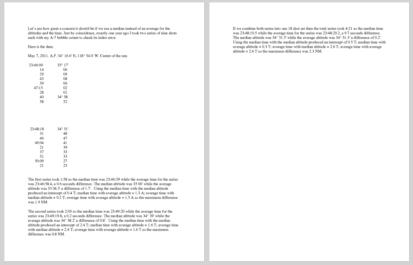
NavList:
A Community Devoted to the Preservation and Practice of Celestial Navigation and Other Methods of Traditional Wayfinding
Re: AN5954 bubble octant by Bausch and Lomb
From: Gary LaPook
Date: 2012 May 8, 02:20 -0700
From: Gary LaPook
Date: 2012 May 8, 02:20 -0700
| Let’s see how great a concern it should be if we use a median instead of an average for the altitudes and the time. Just by coincidence, exactly one year ago I took two series of nine shots each with my A-7 bubble octant to check its index error. (I have attached this as a pdf file because I can never get the format of a data table to come out right in email.) Here is the data: May 7, 2011. A.P. 34̊ 16.6' N, 118̊ 54.0' W. Center of the sun. 23:46:00 35̊ 17' 14 06 29 09 43 08 59 06 47:15 02 28 01 40 34̊ 58 58 52 23:48:18 34̊ 51' 31 48 46 47 49:04 41 21 39 37 33 51 33 50:09 27 21 25 The first series took 1:58 so the median time was 23:46:59 while the average time for the series was 23:46:58.4, a 0.6 seconds difference. The median altitude was 35 06' while the average altitude was 35 04.3' a difference of 1.7'. Using the median time with the median altitude produced an intercept of 0.4 T; median time with average altitude = 1.3 A; average time with median altitude = 0.2 T; average time with average altitude = 1.5 A so the maximum difference was 1.9 NM. The second series took 2:03 so the median time was 23:49:20 while the average time for the series was 23:49:19.8, a 0.2 seconds difference. The median altitude was 34̊ 39' while the average altitude was 34̊ 38.2' a difference of 0.8'. Using the median time with the median altitude produced an intercept of 2.4 T; median time with average altitude = 1.6 T; average time with median altitude = 2.4 T; average time with average altitude = 1.6 T so the maximum difference was 0.8 NM. If we combine both series into one 18 shot set then the total series took 4:21 so the median time was 23:48:10.5 while the average time for the series was 23:48:20.2, a 9.7 seconds difference. The median altitude was 34̊ 51.5' while the average altitude was 34̊ 51.3' a difference of 0.2'. Using the median time with the median altitude produced an intercept of 0.5 T; median time with average altitude = 0.3 T; average time with median altitude = 2.6 T; average time with average altitude = 2.4 T so the maximum difference was 2.3 NM. Seems accurate enough for me especially for flight navigation where the accepted uncertainty in the observation is 7 NM. (2 sigma) gl --- On Sat, 5/5/12, Alexandre E Eremenko <eremenko@math.purdue.edu> wrote:
|







